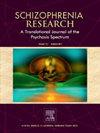AI-based medication adherence prediction in patients with schizophrenia and attenuated psychotic disorders
IF 3.6
2区 医学
Q1 PSYCHIATRY
引用次数: 0
Abstract
Objective
The capacity of machine-learning algorithms to predict medication adherence was assessed using data from AiCure, a computer vision-assisted smartphone application, which records the medication ingestion event.
Methods
Patients treated with BI 409306 were recruited from two Phase II randomized, placebo-controlled trials in schizophrenia (NCT03351244) and attenuated psychotic disorders (NCT03230097). A machine-learning model was optimized to predict overall trial adherence using AiCure data collected over three monitoring periods (7/10/14 days), adherence cut-offs (0.6/0.7/0.8) and timepoints (Start/Mid/End). Area under the curve (AUC), false negative rate, and false omission rate averaged across 10 model cross-validations were analyzed. In NCT03351244, post hoc analyses compared time to first relapse in patients observed as adherent versus those predicted adherent by the model.
Results
Of 235 patients, 60.4 % demonstrated ≥80 % adherence. At an adherence cut-off of 0.8, the 14-day model performed best (AUC: 0.81 versus 0.79 [10-day], 0.77 [7-day]). Within the 14-day model, 0.6 cut-off was optimal (AUC: 0.87 versus 0.85 [0.7 cut-off], 0.81 [0.8 cut-off]). The Trial-End timepoint yielded the most accurate prediction (AUC: 0.92 versus 0.87 [Start], 0.85 [Mid]). Despite NCT03351244 not meeting the primary endpoint, a reduction in risk of first relapse with BI 409306 versus placebo was observed when analyzed with adherent completers (≥80 % across trial; HR = 0.485) and patients with predicted adherence ≥60 % (HR = 0.510).
Conclusions
Adherence data with longer monitoring durations (14 days), lower adherence cut-offs (0.6), and later timepoints (Trial-End) produced most accurate adherence predictions. Accurate adherence prediction provides insights about medication adherence patterns that may help clinicians improve individual adherence.
基于人工智能的精神分裂症和轻度精神障碍患者药物依从性预测。
目的:利用计算机视觉辅助智能手机应用程序AiCure的数据评估机器学习算法预测药物依从性的能力,该应用程序记录药物摄入事件。方法:BI 409306治疗的患者从精神分裂症(NCT03351244)和轻度精神障碍(NCT03230097)的两项II期随机、安慰剂对照试验中招募。通过三个监测期(7/10/14天)收集的AiCure数据、依从性截止值(0.6/0.7/0.8)和时间点(开始/中期/结束),对机器学习模型进行了优化,以预测总体试验依从性。分析了10个模型交叉验证的曲线下面积(AUC)、假阴性率和假遗漏率的平均值。在NCT03351244中,事后分析比较了观察到的依从性患者与模型预测的依从性患者的首次复发时间。结果:在235例患者中,60.4%表现出≥80%的依从性。在依从性临界值为0.8时,14天模型表现最佳(AUC: 0.81 vs 0.79[10天],0.77[7天])。在14天的模型中,0.6临界值为最佳(AUC: 0.87 vs 0.85[0.7临界值],0.81[0.8临界值])。试验结束时间点产生了最准确的预测(AUC: 0.92对0.87[开始],0.85[中期])。尽管NCT03351244未达到主要终点,但与安慰剂相比,BI 409306首次复发的风险降低(整个试验中≥80%;HR = 0.485),患者预测依从性≥60% (HR = 0.510)。结论:较长的监测持续时间(14天)、较低的依从性截止时间(0.6天)和较晚的时间点(试验结束)的依从性数据产生了最准确的依从性预测。准确的依从性预测提供了关于药物依从性模式的见解,可以帮助临床医生提高个人依从性。
本文章由计算机程序翻译,如有差异,请以英文原文为准。
求助全文
约1分钟内获得全文
求助全文
来源期刊

Schizophrenia Research
医学-精神病学
CiteScore
7.50
自引率
8.90%
发文量
429
审稿时长
10.2 weeks
期刊介绍:
As official journal of the Schizophrenia International Research Society (SIRS) Schizophrenia Research is THE journal of choice for international researchers and clinicians to share their work with the global schizophrenia research community. More than 6000 institutes have online or print (or both) access to this journal - the largest specialist journal in the field, with the largest readership!
Schizophrenia Research''s time to first decision is as fast as 6 weeks and its publishing speed is as fast as 4 weeks until online publication (corrected proof/Article in Press) after acceptance and 14 weeks from acceptance until publication in a printed issue.
The journal publishes novel papers that really contribute to understanding the biology and treatment of schizophrenic disorders; Schizophrenia Research brings together biological, clinical and psychological research in order to stimulate the synthesis of findings from all disciplines involved in improving patient outcomes in schizophrenia.
 求助内容:
求助内容: 应助结果提醒方式:
应助结果提醒方式:


